-

人教版新目标初中英语八年级上册Can you come to my party说课稿5篇
二、教学设计与构思根据以上对教材的分析,同时针对学生学习外语存在一定困难的实际情况及学生的年龄特点,首先给学生营造一个温馨愉悦的氛围,创设一个接近学生生活的语言环境,激发学生的学习兴趣,让学生乐于参于以后的活动中,而且每一个环节都配有相应的动画或亲切的画面,让学生在看、听和感知中接受知识,陶冶情操。最后用清晰明了的方式总结知识要点,便于学生巩固复习。在评价学习上,采用多元化评价,尊重差异,富于感性。布置作业时,分两部分,由浅入深,照顾全体学生。三、教学文法通过五步教学法,精讲巧红,由浅入深,以学生为主体,开展师生双边活动。四、教学手段使用现代化教学手段,多媒体辅助教学贯穿整个教学过程,增加直观性和趣味性,提高教学效果。
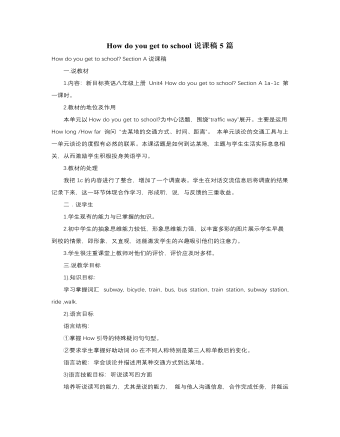
人教版新目标初中英语八年级上册How do you get to school说课稿5篇
难点:1.学会谈论并描述使用某种交通工具到达某地。2.要求学生掌握好助动词do在不同人称特别是第三人称单数后的变化。通过合作学习将听说读写有机地结合起来,切实做到任务密集度适中,节奏合理,环节与环节之间过渡自然,让学生一步步登上高峰突破难点。五.说教学策略:1.教学手段分析:针对低起点的学生,在学习过程中通过“兵交兵,小组训练,鼓励性评价”等扶路措施,提高低起点学生的语言技能。针对高起点的学生要拔高学习目标,同时又能较好地运用到实践中去。2.教学方法分析:本课主要以“任务型教学法”并辅助与情境交际法完成任务的。在教学活动中采用任务型教学法让学生的学习活动具有明确的目标,并构成有梯度的连续活动。学生从注重语言本身转变为注重语言习得,从而获得语言运用的能力。我还采用情境交际法给学生足够的听,说的机会,联系实际,创设情景,在交际中学英语。
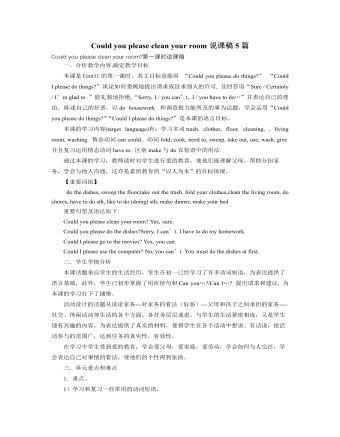
人教版新目标初中英语八年级上册Could you please clean your room说课稿5篇
三、教学准备 复习动词短语,并且预习生词, 游戏用的卡片 小奖品四、说教学方法与手段1.口语教学,在真实的语境下进行对话交际,复习旧知识,认识新事物,学习新内容。2.单词教学游戏化,寓教于乐,让学生学得开心,记得舒心。3. 利用信息沟活动,给学生设置了信息差,激发了学生的询问欲望,真正使语言起到了交流思想的作用。4.听说读写全面训练,从在听说的基础上,发展读写的技能。本节课着重写的能力,让学生从听写单词到看图写句子,由简到难,循序渐进。5.小组合作,师生对话,生生对话。五、说教材处理与学法指导1.将教材内容分为三部分。第一部分为口语操练为主,完成Section B,3,在复习旧句型的前提下学习Could you please clean your room?并能熟练进行对话。2.第二部分是听力练习,训练学生对新学单词的听辨能力和从对话中获取信息并作好记录的能力。4.第三部分是一个写的练习,是对上一节课的语法聚焦的巩固和提高,也是第二部分口头表达的延伸,是学生书面表达的起步。
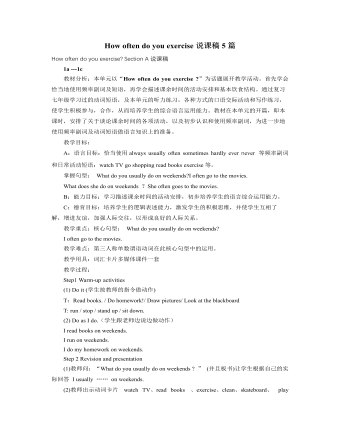
人教版新目标初中英语八年级上册How often do you exercise说课稿5篇
1a ---1c教材分析:本单元以“How often do you exercise ?”为话题展开教学活动。首先学会恰当地使用频率副词及短语,再学会描述课余时间的活动安排和基本饮食结构。通过复习七年级学习过的动词短语,及本单元的听力练习,各种方式的口语交际活动和写作练习,使学生积极参与,合作,从而培养学生的综合语言运用能力。教材在本单元的开篇,即本课时,安排了关于谈论课余时间的各项活动,以及初步认识和使用频率副词,为进一步地使用频率副词及动词短语做语言知识上的准备。教学目标:A:语言目标:恰当使用always usually often sometimes hardly ever never 等频率副词和日常活动短语:watch TV go shopping read books exercise等。掌握句型: What do you usually do on weekends?I often go to the movies.What does she do on weekends ?She often goes to the movies.B:能力目标:学习描述课余时间的活动安排,初步培养学生的语言综合运用能力。C:德育目标:培养学生的逻辑表述能力,激发学生的积极思维,并使学生互相了解,增进友谊,加强人际交往,以形成良好的人际关系。
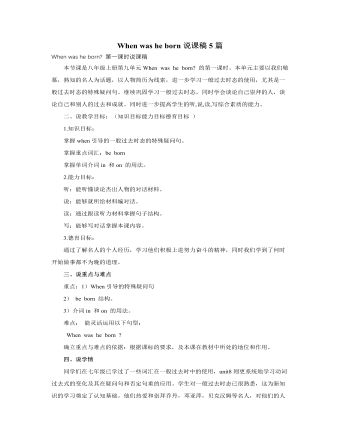
人教版新目标初中英语八年级上册When was he born说课稿5篇
1. 教学重点(1)新单词及目标语言的掌握。(2)听、说、读、写的综合训练。(3)对对合作及小组合作练习口语的训练。2. 教学难点(1)when所引导的特殊疑问句。(2)询问生日与出生年月日的区别。When is your birthday? (一般现在时)When were you born?(一般过去时) (3)表达年月日时所用的不同介词:in+年/月;on+日期二、教学方法。由浅入深,由易到难,由已知到未知,从学生熟悉的运动明星、电影明星甚至是歌手入手,调动他们的学习积极性,让他们在心情愉快、兴趣浓厚的氛围中展开一系列听说读写的训练,主动地投入到学习中去,自然地掌握本单元的重点、难点;循序渐进地深化教学内容,同时以训练学生听说为主,展开以老师为主导,以学生为主体的师生双边互动活动。三、教学手段。利用名人图片来辅助新的语言知识的巩固和训练;采用多媒体教学,并把听力内容录到电脑中,锻炼了学生的视听能力,提高了教学效果。
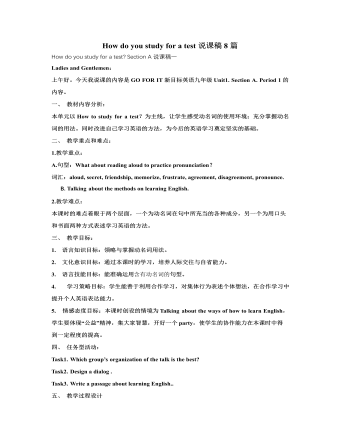
人教版新目标初中英语九年级上册How do you study for a test说课稿8篇
教学反思:这是学生升入初三的第一节课,学生学习热情很高,通过这一课时的学习,学生掌握了语言目标中所要求的知识重点、难点和语言技能,如by dong, practicing doing ,too……to,现在完成时态,动名词短语做主语及提建议的几种方式,但是有部分学生由于基础较差,还需要从培养学生学习兴趣入手,真正实现教育面向全体学生。在教学中采取的具体办法由:个别辅导,互助学习,留不同层次夫人作业,争取让每一位学生都吃饱而不掉队。How do you study for a test?Two periodsSection BGoals●To listen about learning English●To talk about learning English●To read about learning EnglishProceduresWarming up by reading to the recordingHello, everyone. To begin with, let’s listen and read to the recording of the text HOW DO YOU LEARN BEST? That is, read aloud to the tape, as fast as the tape goes, as clearly as the native reader reads. OK? Here we go!My cat speaks English. Sometimes my cat comes to me and tells me that she is hungry. Or that her leg hurts. How does my cat tell me these things? I don't speak pussy-cat language.1a Reading and checkingLearning English can be both easy and difficult. What things are easy for you? And what things are difficult for you? Now turn to page 5, read the list on the top and check √the statements that are true for you.1b Making a listYou have read and checked the statements true for you. Now think and make a list of other things difficult for you, too.
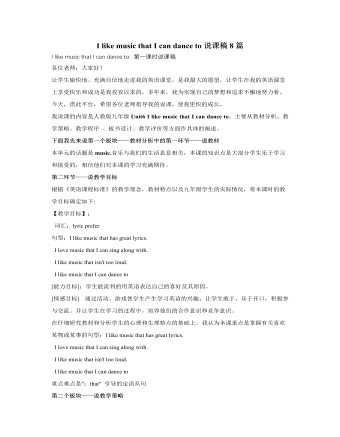
人教版新目标初中英语九年级上册I like music that I can dance to说课稿8篇
2、 难点结合功能句进行听力练习。确定目标的根据新课程标准规定,通过听、说、读、写的训练,使学生获得英语基础知识和初步运用英语进行交际的能力,激发学生的学习兴趣,为进一步的学习打基础。此外,根据我国国情及新课程标准的要求,现阶段英语教学的素质主要包括思想素质教育,潜在英语能力的培养,非智力因素的培养等几个方面。而我们班的学生本身英语基础不太好,部分学生已经对英语失去了信心,还有一部分学生觉得英语越来越难,渐渐力不从心了,不感兴趣了,上课注意力也不集中了。针对这种情况,备课时要增加趣味性,以此来提高学生对英语的学习兴趣。二、教法学法1、 教法:采取“任务型”教学法。教师根据本节课内容,安排合适的任务,让学生在完成任务的过程中达到本节课所拟定的目标。
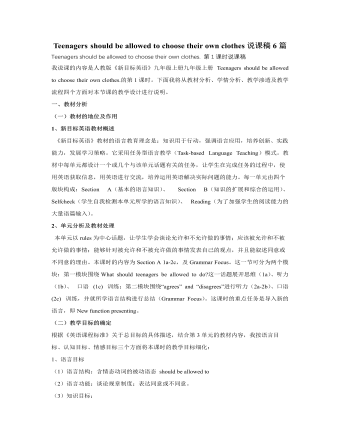
人教版新目标初中英语九年级上册Teenagers should be allowed to choose their own clothes说课稿6篇
二、教材分析本课时主要是以听和说的方式来谈论一些家庭和学校的“规矩和制度”,知道那些时可以做的,那些是不可以做的,让学生先从口头上了解这些规矩和制度,为后面的学习做好准备。三、教学的目的和要求1. 掌握短语be strict with sb.的用法,并介绍be strict in sth.的用法;2. 学生能够根据所学的知识,了解用什么方式/句型来制定规章制度。3. 多听,提高学生的习愿望,敦促学生开口说英语,用本课所学的知识来表达自己的意见。四、教学重点和难点1. 如何正确使用be allowed to do…这一句型(在不同时态中的被动语态运用)。2. 如何获得听力技巧及口语技能的提高。五、教学过程T—teacher S—studentS s—students Bb—blackboardStep 1 Warming up Check their homework first, and see if the Ss can make sentences by using the rules in 4, Section A. If possible, try to give some help.

小学数学人教版一年级上册《6、7加减法的应用》说课稿
说课内容:我说课的内容是人教版小学数学一年级上册第五单元、第三课时、6、7的加减法应用。我将从教材分析,教学目标分析,教学重难点及突破方法,教学流程设计,4个方面来进行说课。一、说教材:1、内容:本节课是在学生学习6、7加减法的基础上展开教学的,教材第一次出现用情景图呈现数学问题的形式,呈现了一个简单求和求差的数学问题,使学生明确、知道两个相关的信息和一个相关的问题,就构成了一个简单的数学问题。2、地位:从整个知识网络来看,它也标志着数学应用题数学的开始,是向后面的文字应用题过度的桥梁。二、说教学目标通过对教材的分析,确立了如下教学目标:1.通过学习使学生认识理解大括号和问号的意义,能借助图画正确分析题意。2.会用6和7的加减法解决生活中简单问题,使学生切实感受到用学过的数学知识去解决简单的实际问题的过程。3.初步感受数学与日常生活的密切联系,体验学数学、用数学的乐趣。
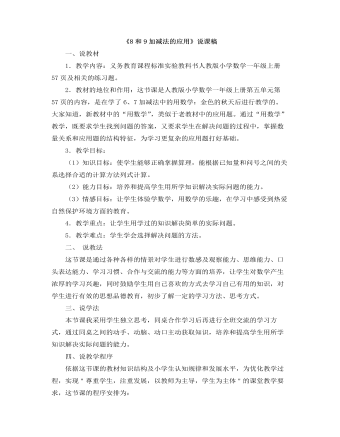
小学数学人教版一年级上册《8和9加减法的应用》说课稿
一、说教材1.教学内容:义务教育课程标准实验教科书人教版小学数学一年级上册57页及相关的练习题。2.教材的地位和作用:这节课是人教版小学数学一年级上册第五单元第57页的内容,是在学了6、7加减法中的用数学:金色的秋天后进行教学的。大家知道,新教材中的“用数学”,类似于老教材中的应用题。通过“用数学”教学,既要求学生找到问题的答案,又要求学生在解决问题的过程中,掌握数量关系和应用题的结构特征,为学习更复杂的应用题打好基础。3.教学目标:(1)知识目标:使学生能够正确掌握算理,能根据已知量和问号之间的关系选择合适的计算方法列式计算。(2)能力目标:培养和提高学生用所学知识解决实际问题的能力。(3)情感目标:让学生体验学数学,用数学的乐趣,在学习中感受到热爱自然保护环境方面的教育。4.教学重点:让学生用学过的知识解决简单的实际问题。5.教学难点:学生学会选择解决问题的方法。
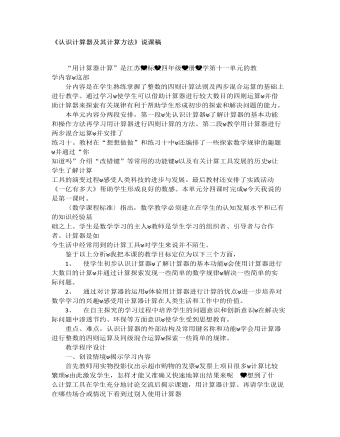
小学数学人教版四年级上册《认识计算器及其计算方法》说课稿
“用计算器计算”是江苏国标版四年级上册数学第十一单元的教学内容这部分内容是在学生熟练掌握了整数的四则计算法则及两步混合运算的基础上进行教学。通过学习使学生可以借助计算器进行较大数目的四则运算并借助计算器来探索有关规律有利于帮助学生形成初步的探索和解决问题的能力。 本单元内容分两段安排,第一段先认识计算器了解计算器的基本功能和操作方法再学习用计算器进行四则计算的方法。第二段教学用计算器进行两步混合运算并安排了练习十。教材在“想想做做”和练习十中还编排了一些探索数学规律的趣题并通过“你知道吗”介绍“改错键”等常用的功能键以及有关计算工具发展的历史让学生了解计算工具的演变过程感受人类科技的进步与发展。最后教材还安排了实践活动《一亿有多大》帮助学生形成良好的数感。本单元分四课时完成今天我说的是第一课时。
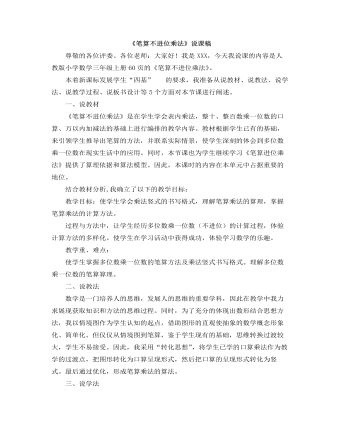
小学数学人教版三年级上册《笔算不进位乘法》说课稿
一、说教材《笔算不进位乘法》是在学生学会表内乘法,整十、整百数乘一位数的口算、万以内加减法的基础上进行编排的教学内容。教材根据学生已有的基础,来引领学生推导出笔算的方法,并联系实际情景,使学生深刻的体会到多位数乘一位数在现实生活中的应用。同时,本节课也为学生继续学习《笔算进位乘法》提供了算理依据和算法模型。因此,本课时的内容在本单元中占据重要的地位。结合教材分析,我确立了以下的教学目标:教学目标:使学生学会乘法竖式的书写格式,理解笔算乘法的算理,掌握笔算乘法的计算方法。过程与方法中,让学生经历多位数乘一位数(不进位)的计算过程,体验计算方法的多样化。使学生在学习活动中获得成功,体验学习数学的乐趣。教学重、难点:使学生掌握多位数乘一位数的笔算方法及乘法竖式书写格式。理解多位数乘一位数的笔算算理。
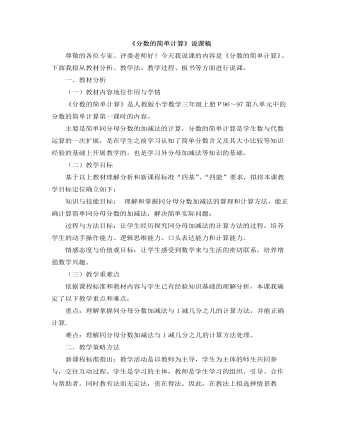
小学数学人教版三年级上册《分数的简单计算》说课稿
一.教材分析(一)教材内容地位作用与学情《分数的简单计算》是人教版小学数学三年级上册P96~97第八单元中的分数的简单计算第一课时的内容。主要是简单同分母分数的加减法的计算,分数的简单计算是学生数与代数运算的一次扩展,是在学生之前学习认知了简单分数含义及其大小比较等知识经验的基础上开展教学的。也是学习异分母加减法等知识的基础。(二)教学目标基于以上教材理解分析和新课程标准“四基”、“四能”要求,拟将本课教学目标定位确立如下:知识与技能目标: 理解和掌握同分母分数加减法的算理和计算方法,能正确计算简单同分母分数的加减法,解决简单实际问题;过程与方法目标:让学生经历探究同分母加减法的计算方法的过程。培养学生的动手操作能力、逻辑思维能力、口头表达能力和计算能力。情感态度与价值观目标:让学生感受到数学来与生活的密切联系,培养增强数学兴趣。
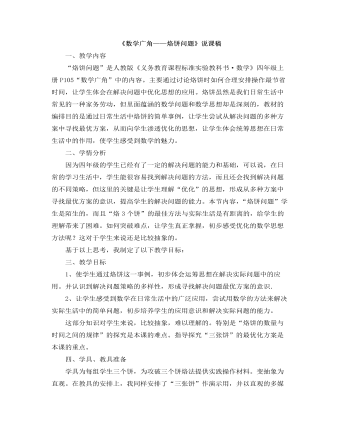
小学数学人教版四年级上册《数学广角——烙饼问题》说课稿
第一个板块是“脑筋急转弯”,激发学习兴趣。目的有两个:一是拉近与学生的距离,二是为本节课做铺垫。第二板块是自主探究,优化策略。这一部分内容通过“操作感悟——抽象内化——巩固应用”三个片段,使学生在教师的点拨引导下,沿以下四个步骤:“一张和两张饼的烙法(基础)→三张饼的最佳烙法(难点)→双数饼、单数饼的烙法(提升)→最佳方案、双数饼:两张两张烙;单数饼:两张两张烙+最后3张饼交叉烙(优化)进行探究。1、探索烙3张饼的最少时间是本节课的重点也是难点,优化的数学思想只能是“渗透”而不能“明透”,也就是说只能让学生在潜移默化的过程中理解,而不能仅仅靠传授。因此,本课中蓄势----为探索最佳方法打基础的方法,自认为运用得恰到好处。例如,围绕“烙2张饼最少要花6分,为什么烙1张饼与2张饼所用的时间一样多呢?你们是怎么想的?”这个问题,让学生体会烙2张饼是用足了空间,而烙1张饼浪费了空间和时间,为探索烙3张饼埋下了伏笔。
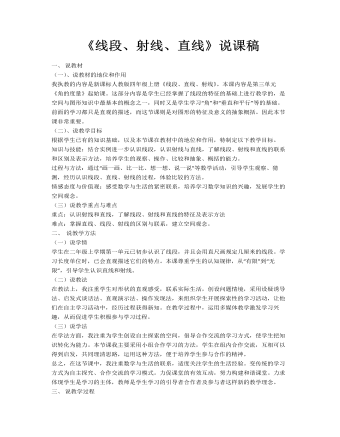
小学数学人教版四年级上册《线段、射线、直线》说课稿
(一)情境导入以鲜明的色彩、生动的画面演绎激光从地球发送到月球的全过程,既引出了学过的线段,又激发学生探究新知的欲望。(二) 质疑探究在讲授新课的过程中,我选择了多媒体的教学手段。这些教学手段的运用可以使抽象的知识具体化,枯燥的知识生动化,乏味的知识兴趣化。1、认识线段。通过多媒体演绎,使学生对于抽象的“线段”的认识建立在具体的生活模型基础上,有助于学生认识图形特征,形成表象,感受生活中处处有数学。这一环节主要引导学生回顾所学的线段知识,通过画图、说特征、举例子、讲授字母表示法这一系列活动,使学生进一步认识线段。2、 认识射线。多媒体课件形象、生动地演示了激光在宇宙中不断延长,再延长,通过直观感知,在头脑中建立“无限延长”的表象,帮助学生理解“无限延长”的含义。通过教师引导和小组合作,共同学习射线的画法、特征及字母表示法,进而把所学知识还原到生活当中,让学生明确数学与生活紧密联系。
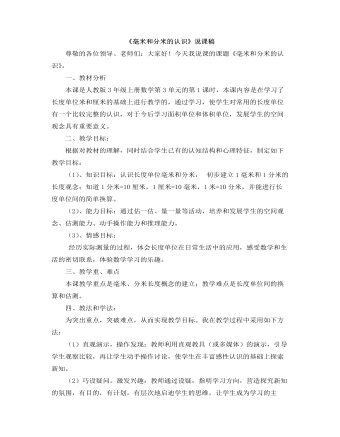
小学数学人教版三年级上册《毫米和分米的认识》说课稿
一、教材分析本课是人教版3年级上册数学第3单元的第1课时,本课内容是在学习了长度单位米和厘米的基础上进行教学的,通过学习,使学生对常用的长度单位有一个比较完整的认识,对于今后学习面积单位和体积单位,发展学生的空间观念具有重要意义。二、教学目标:根据对教材的理解,同时结合学生已有的认知结构和心理特征,制定如下教学目标:(1)、知识目标:认识长度单位毫米和分米, 初步建立1毫米和1分米的长度观念;知道1分米=10厘米,1厘米=10毫米,1米=10分米,并能进行长度单位间的简单换算。(2)、能力目标:通过估一估、量一量等活动,培养和发展学生的空间观念、估测能力、动手操作能力和推理能力。(3)、情感目标:经历实际测量的过程,体会长度单位在日常生活中的应用,感受数学和生活的密切联系,体验数学学习的乐趣。
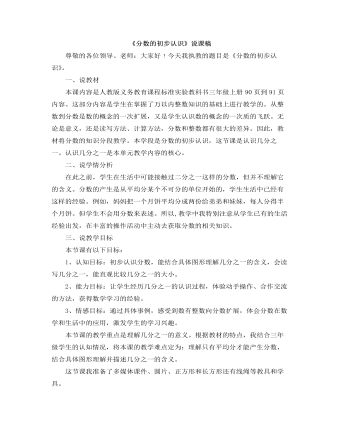
小学数学人教版三年级上册《分数的初步认识》说课稿
一、说教材本课内容是人教版义务教育课程标准实验教科书三年级上册90页到91页内容。这部分内容是学生在掌握了万以内整数知识的基础上进行教学的。从整数到分数是数的概念的一次扩展,又是学生认识数的概念的一次质的飞跃。无论是意义,还是读写方法、计算方法,分数和整数都有很大的差异。因此,教材将分数的知识分段教学。本学段是分数的初步认识,这节课是认识几分之一。认识几分之一是本单元教学内容的核心。二、说学情分析在此之前,学生在生活中可能接触过二分之一这样的分数,但并不理解它的含义。分数的产生是从平均分某个不可分的单位开始的,学生生活中已经有这样的经验。例如,妈妈把一个月饼平均分成两份给弟弟和妹妹,每人分得半个月饼。但学生不会用分数来表述。所以,教学中我特别注意从学生已有的生活经验出发,在丰富的操作活动中主动去获取分数的相关知识。
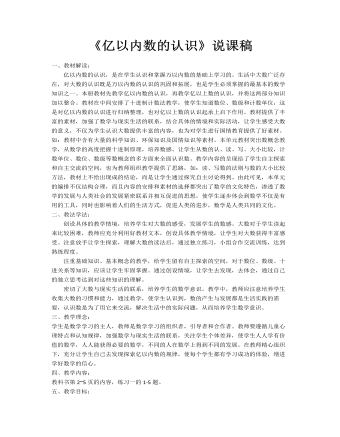
小学数学人教版四年级上册《亿以内数的认识》说课稿
三、教学理念:学生是数学学习的主人,教师是数学学习的组织者,引导者和合作者。教师要遵循儿童心理特点和认知规律,加强数学与现实生活的联系,关注学生个体差异,使学生人人学有价值的数学,人人能获得必要的数学,不同的人在数学上得到不同的发展。在教师精心组织下,充分让学生自己去发现探索亿以内数的规律,使每个学生都有学习成功的体验,增进学好数学的信心。四、教学内容:教科书第2~5页的内容,练习一的1-5题。五、教学目标:1.使学生认识计数单位"万""十万""百万""千万"和"亿",知道亿是个大数;知道亿以内各计数单位的名称和相邻两个单位之间的十进关系。2.掌握数位顺序,理解并掌握我国四位一级的计数习惯,能够根据数级正确地读出亿以内的数。3.通过情境创设,小组合作学习等形式,使学生获得正确读数的成功体验;培养学生分析、综合的能力。4.培养学生对大数的感受,发展学生的数感。六、教学重点:亿以内数的认识,读法。七、教学难点:1. 数级、数位、计数单位的区别以及"位值"的理解。2.每级中间或末尾有0的读法。八、教具学具:教师准备PPT课件,数位表,师生都备计数器。
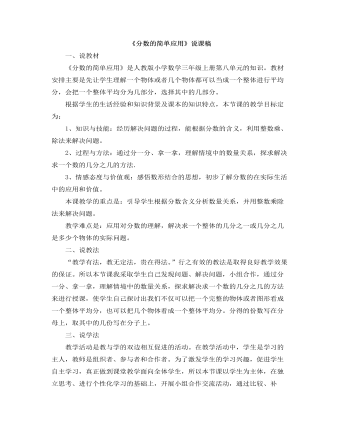
小学数学人教版三年级上册《分数的简单应用》说课稿
一、说教材《分数的简单应用》是人教版小学数学三年级上册第八单元的知识。教材安排主要是先让学生理解一个物体或者几个物体都可以当成一个整体进行平均分,会把一个整体平均分为几部分,选择其中的几部分。根据学生的生活经验和知识背景及课本的知识特点,本节课的教学目标定为:1、知识与技能:经历解决问题的过程,能根据分数的含义,利用整数乘、除法来解决问题。2、过程与方法:通过分一分、拿一拿,理解情境中的数量关系,探求解决求一个数的几分之几的方法.3、情感态度与价值观:感悟数形结合的思想,初步了解分数的在实际生活中的应用和价值。本课教学的重点是:引导学生根据分数含义分析数量关系,并用整数乘除法来解决问题。
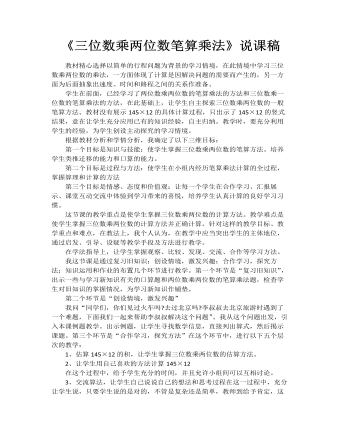
小学数学人教版四年级上册《三位数乘两位数笔算乘法》说课稿
根据教材分析和学情分析,我确定了以下三维目标:第一个目标是知识与技能:使学生掌握三位数乘两位数的笔算方法。培养学生类推迁移的能力和口算的能力。第二个目标是过程与方法:使学生在小组内经历笔算乘法计算的全过程,掌握算理和计算的方法第三个目标是情感、态度和价值观:让每一个学生在合作学习、汇报展示、课堂互动交流中体验到学习带来的喜悦,培养学生认真计算的良好学习习惯。这节课的教学重点是使学生掌握三位数乘两位数的计算方法。教学难点是使学生掌握三位数乘两位数的计算方法并正确计算。针对这样的教学目标、教学重点和难点,在教法上,我个人认为,在教学中应当突出学生的主体地位,通过启发、引导、设疑等教学手段及方法进行教学。

